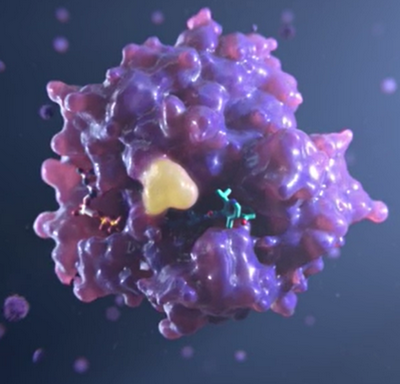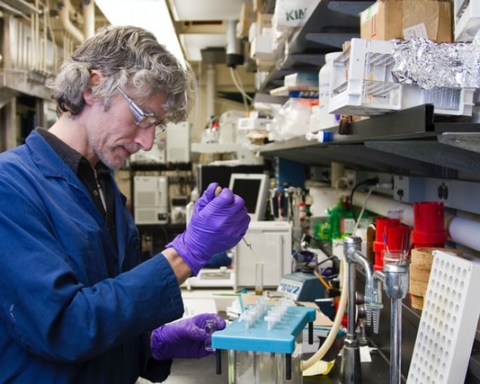Drug delivery is not as easy as simply getting the right drug into contact with the right cells. We need to consider factors such as how the drug will reach its target site, how long it will remain at the site before degrading, and what impact it may have on non-target cells.
Advances in nanotechnology could have fascinating real-life implications for improving the accuracy and effectiveness of drug delivery. It could many treatments, especially ones where the drug can have a negative side-effect on healthy cells.
For diseases such as cancer, we want drugs to specifically target the cancer cells alone and do as little damage to nearby healthy cells as possible. In addition to being accurate, drugs need to be able to avoid natural immune of the human body and be able to move through tissue from the point of delivery.
Nanomaterials
Nano-sized materials have incredible potential for the fast and targeted delivery of drugs to specific areas of the body. Delivering medicine at the nanoscale is less invasive and could ensure that drugs are delivered to the exact place they’re needed.
Most biological interactions occur at the nano level, or in other words, at a scale one billionth the size of a meter. This means that being able to manipulate nanomaterials of a similar size is extremely useful and applicable to a wide range of medicine.
Due to their minuscule size, nanoparticles have a high surface area to volume ratio, giving them a large contact area when interacting with their targets. Lots of different functional groups can be added to this surface area, allowing for a diverse set of chemical functionalities.
Implications for targeting in cancer treatment
Cancer treatments such as chemotherapy can extract a heavy toll on patients. Whilst still largely in research and development, pre-clinical trials have suggested that nanoparticles could be a valuable tool for delivering drugs to cancerous cells. Researchers are working to develop complex ways for nanoparticles to avoid the body’s immune defences and move through the body to target areas.
Specific functional groups can be added to nanoparticles, enabling them to accurately target cancerous cells and accumulate at the site. This selective way of attacking cancer cells reduces the risk of damaging healthy cells in the process.
Due to their tiny size, nanoparticles are able to effectively act as molecules and pass through cell membranes. Researchers are hoping to be able to exploit this by creating nanoparticles that pass through cell membranes and release drugs into the cell cytoplasm. This would help to prevent tissue damage caused by exposure to drugs being released to other areas.
How cancer cells can be killed via nanotechnology
An example of how this kind of targeted drug delivery would work is how bismuth nanoparticles can be used to concentrate the radiation used in cancer treatment. Molecules attracted to cancerous prostate cells can be joined to radioactive gold nanoparticles. These nanoparticles will then bind to the specific cancer cells only, helping to minimise the damage done to healthy cells by the radiation.
Another method of killing cancer cells with nanotechnology is through the use of targeted heat via gold nanorods. Strands of DNA are used as a scaffold, holding the nanorod and a chemotherapy drug in place together. The gold nanorod can then bind and attach to a tumour cell, ready for the chemotherapy drug to be released.
This is achieved by striking the tumour with infrared light, causing the gold nanorod to heat up, releasing the drug and killing the tumour cell. Research is ongoing into how to deploy this method to fight breast cancer, by using antibodies strongly attracted to proteins produced in breast cancer cells.
Applications for other illnesses
This method of targeted drug delivery is not restricted to fighting cancer. Nanomaterials can be targeted to many tissues, with one use being to deliver stem cells to damaged cardiac tissue. The particles home in on inflamed tissue such as atherosclerosis plaque and bind to release their attached drug.
In welcome news to anybody who is required to inject themselves with insulin twice a day, researchers are developing nanoparticles that release insulin when they detect changes to glucose levels. The particles would be present in the blood and only dissolve when high levels of glucose were detected.
This could allow the insulin contained within the particle to be released into the bloodstream when needed, and avoid the requirement for intrusive injections.
Obstacles
Despite having undoubted potential, further research will be required to better understand the limitations of this technology. There are fears from some over nanotoxicity and whether some nanomaterial may pass into tissue it wasn’t intended for.
Whilst laboratory tests have shown a number of promising avenues for nanotechnology, there are still some concerns over the use of nanoparticles in the human body. Host bodies can have complex reactions to nanoparticles, with effects of nanomedicine varying from patient to patient.
The scope of what can be achieved in medicine with nanotechnology is vast, and it will surely have a growing impact as time and technology progress.
About The Author
Marcus White is a freelance biotechnology writer based in the U.K. Feel free to check out his website here or connect with him on Twitter.








